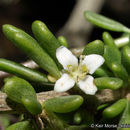pt-BR
nomes no trilho de navegação


Lycium californicum (lat. Lycium californicum) - badımcankimilər fəsiləsinin itüzümü cinsinə aid bitki növü.
Lycium californicum (lat. Lycium californicum) - badımcankimilər fəsiləsinin itüzümü cinsinə aid bitki növü.
Lycium californicum ist eine Pflanzenart aus der Gattung der Bocksdorne (Lycium) in der Familie der Nachtschattengewächse (Solanaceae).
Lycium californicum ist ein 0,1 bis 2 m hoher, verworren verzweigter, niederliegender oder kriechender Strauch. Seine Laubblätter sind sukkulent, 2 bis 25 mm lang und 1 bis 3 mm breit.
Die Blüten treten in zweierlei Gestalt auf und sind vierzählig. Der Kelch ist glockenförmig und flaumhaarig behaart. Die Länge der Kelchröhre beträgt 2 bis 2,5 mm, die Kelchzipfel sind etwa 1/3 so lang wie die Kelchröhre. Die Krone ist weiß bis blass purpurn gefärbt. Die Kronröhre ist 2 bis 4,5 mm lang, die Kronlappen sind in etwa genauso lang oder nur leicht kürzer.
Die Frucht ist eine eiförmige, orange-rote oder rote Beere. Jedes Fruchtblatt bildet nur einen einzigen Samen aus.
Die Chromosomenzahl beträgt 2n = 24, 36 oder 48.[1]
Die Art ist in Nordamerika verbreitet und kommt dort in den mexikanischen Bundesstaaten Baja California, Baja California Sur, Coahuila, Sinaloa, Zacatecas, Sonora und San Luis Potosí, sowie in den amerikanischen Bundesstaaten Arizona und Kalifornien vor.
Innerhalb der Art werden vier Varietäten unterschieden:
Molekularbiologische Untersuchungen platzieren die Art zusammen mit Lycium nodosum und Lycium vimineum in einer deutlich unterstützten Klade, Lycium californicum bildet eine Schwesterklade zu den beiden anderen Arten.[2][3]
Lycium californicum ist eine Pflanzenart aus der Gattung der Bocksdorne (Lycium) in der Familie der Nachtschattengewächse (Solanaceae).
Lycium californicum is a spreading shrub in the nightshade family known by the common names California boxthorn and California desert-thorn.
This plant, as Lycium californicum var. californicum, is native to the Coastal sage scrub and coastal bluffs along the coast of Southern California to northern Baja California and the northern and southern Channel Islands. As Lycium californicum var. arizonicum it is found in the Sonoran Desert in southern Arizona.[1][2]
This thorny shrub, with rigid-spreading branches. Has thick, fleshy, bulbous 3–10 millimetres (0.12–0.39 in) green leaves. The widely triangular bell-shaped white flowers have purple streaks or spots. It bears bright red shiny berries 3–6 millimetres (0.12–0.24 in) in diameter, and oblong seeds.[2]
The shrub variety Lycium californicum var. californicum is a member of the chaparral ecosystem and other plant communities of the direct coastline from Santa Barbara County south into Baja California, below 150 m. It is most plentiful in the ecotone between salt marshes-estuaries and the coastal sage scrub plant community. The destruction of this specific ecotone in this highly developed region has led to a reduction in the population of this plant there.[3] It extends into the Inland Empire floodplains.[2]
Another variety, Lycium californicum var. arizonicum, is found in riparian Arroyos in the Yuma Desert, Tule Desert, and greater Sonoran Desert across southern Arizona.[4]
Lycium californicum is a spreading shrub in the nightshade family known by the common names California boxthorn and California desert-thorn.
This plant, as Lycium californicum var. californicum, is native to the Coastal sage scrub and coastal bluffs along the coast of Southern California to northern Baja California and the northern and southern Channel Islands. As Lycium californicum var. arizonicum it is found in the Sonoran Desert in southern Arizona.
Lycium californicum là loài thực vật có hoa trong họ Cà. Loài này được A. Gray mô tả khoa học đầu tiên năm 1876.[1]
Lycium californicum là loài thực vật có hoa trong họ Cà. Loài này được A. Gray mô tả khoa học đầu tiên năm 1876.